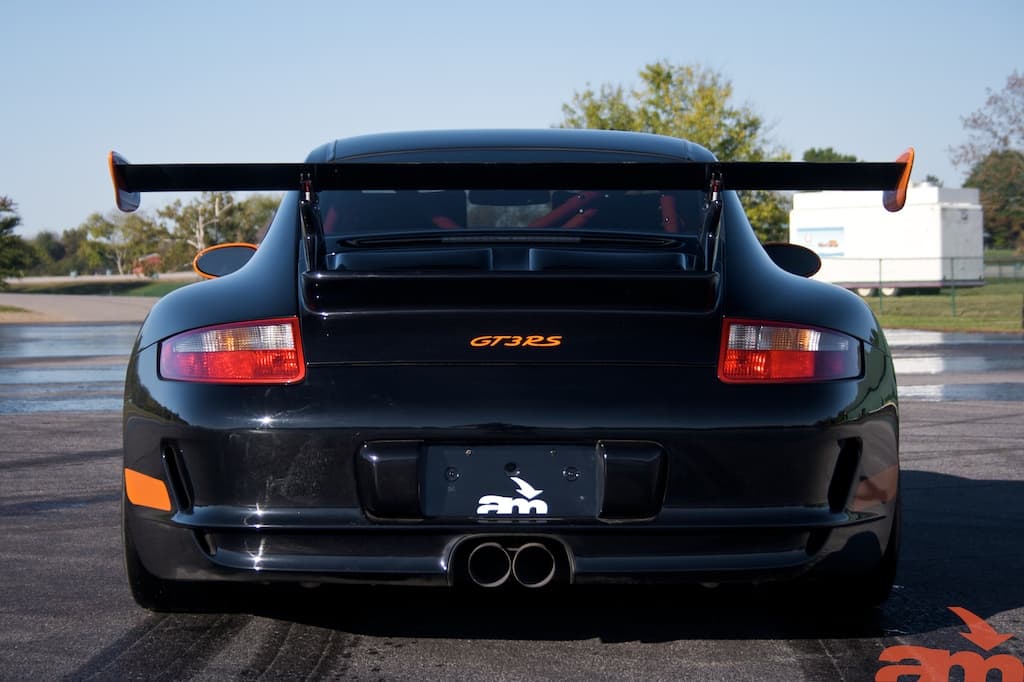
Incredible Aero for the Ultimate Porsche Platform
If you want the best aero, you have to do the math. It started by 3D scanning the GT3 RS into our aero simulator for precision design and analysis. From there, the shape is optimized to increase the grip, and reduce the tendency of the 911 to rotate. What’s this added control worth? 1.6 seconds off a two minute lap.
Track verified, podium approved.
Craig Stanton is no stranger to Porsches. Winning Koni Challenge and Grand-Am championships in Porsches, he knows how to extract every bit of performance from the 911. In back-to-back testing of the stock 57″ wing, versus the 65″ Dynamic wing, Craig picked up over 12 MPH on the front straight, over 8 MPH at the end of the uphill esses, over 7 MPH on the back straight, and knocked off more than 1.6 seconds over a full lap at VIR. More than once he said that the 65″ high-downforce blade saved him from spins.
More rear grip! Stay on the edge of the traction circle.
The 911 is a unique platform. The rear engine design merits a different aero package than her front and mid-engine competitors – she wants more downforce. The more you dial in, the faster she goes, and the difference in handling is amazing.
Size Matters.
The Aeromotions wings are available in two sizes, 57” like the stock GT3 RS, and 65” for maximum traction and performance. The extra width helps keep the rear of the car where it belongs, in back.
GT3 57″ vs. 65″ Blade
Static wing. The 1.5 second difference.
Upgrading to the 65″ Aeroomotions blade stabilized the rear end. On the first lap out, Craig was raving about the stability – so much so – he took one hand off the wheel to show how easy and controllable the car had become. The stability was evident over the entire track. At the top of the climbing S’s, the car was planted. The difference was night and day.
Post VIR development
THE DYNAMIC FRONT SPLITTER. DEVELOPED AFTER VIR.
After VIR, development moved to the front of the car. With static aero, Porsche chose two different routes on the 997.1 GT3, and the 997.2 GT3. On the 997.1 GT3, Porsche integrated brake ducts in the front splitter. The air that pours in these inlets reduces front downforce by 10-15%, but enables better brake cooling. On the 997.2 GT3, Porsche closed the ducts to increase front downforce. With the Dynamic front splitter, you get the best of both worlds. Automatically.
GT3 CFD
DYNAMIC SPLITTER.
GT3_S2-Splitter_Front-Duct
When the wing drops on the straightaways – to reduce drag – the rear downforce drops as well. This gives the car a slight tendency to rotate, which is exacerbated by the rear-engine design (compared to front engine vehicles). To combat this, the front ducts of the Dynamic Spliiter open up, pouring high-pressure air under the front of the car, and dropping the front downforce by 25%. Balance is maintained. The Dynamic inlet is shown in yellow, behind the front splitter opening.
THE UNDERBODY AERO.
The downforce developed from “ground effect”, or underbody aero, is the result of low pressure air sucking the car to the ground. The front splitter is designed to force the air over the top of the car, creating a low pressure zone under the car. Since the low pressure sucks air in from the sides of the car, the greatest effect of the splitter is seen in the front of the car. This CFD model of the undercarriage shows the top duct open, and the bottom duct closed. Note the higher pressure air on the open side (top), compared to the low pressure blue zone on the bottom side. This high pressure air reduces front downforce, and also sends a jet of cold air to the front brakes.
GT3 Under Body CFD

